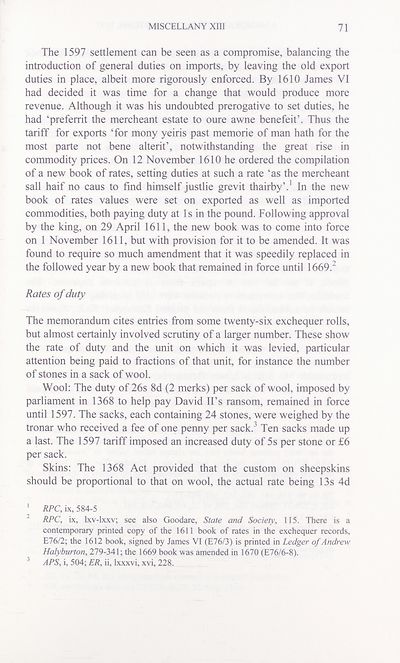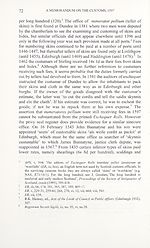Series 5 > Miscellany [of the Scottish History Society] XIII
(86) Page 71
Download files
Complete book:
Individual page:
Thumbnail gallery: Grid view | List view

MISCELLANY XIII
71
The 1597 settlement can be seen as a compromise, balancing the
introduction of general duties on imports, by leaving the old export
duties in place, albeit more rigorously enforced. By 1610 James VI
had decided it was time for a change that would produce more
revenue. Although it was his undoubted prerogative to set duties, he
had ‘preferrit the mercheant estate to oure awne benefeit’. Thus the
tariff for exports ‘for mony yeiris past memorie of man hath for the
most parte not bene alterit’, notwithstanding the great rise in
commodity prices. On 12 November 1610 he ordered the compilation
of a new book of rates, setting duties at such a rate ‘as the mercheant
sail haif no caus to find himself justlie grevit thairby’.1 In the new
book of rates values were set on exported as well as imported
commodities, both paying duty at Is in the pound. Following approval
by the king, on 29 April 1611, the new book was to come into force
on 1 November 1611, but with provision for it to be amended. It was
found to require so much amendment that it was speedily replaced in
the followed year by a new book that remained in force until 1669.2
Rates of duty
The memorandum cites entries from some twenty-six exchequer rolls,
but almost certainly involved scrutiny of a larger number. These show
the rate of duty and the unit on which it was levied, particular
attention being paid to fractions of that unit, for instance the number
of stones in a sack of wool.
Wool: The duty of 26s 8d (2 merks) per sack of wool, imposed by
parliament in 1368 to help pay David ITs ransom, remained in force
until 1597. The sacks, each containing 24 stones, were weighed by the
tronar who received a fee of one penny per sack.3 Ten sacks made up
a last. The 1597 tariff imposed an increased duty of 5s per stone or £6
per sack.
Skins: The 1368 Act provided that the custom on sheepskins
should be proportional to that on wool, the actual rate being 13s 4d
1 RPC, ix, 584-5
2 RPC, ix, Ixv-lxxv; see also Goodare, State and Society, 115. There is a
contemporary printed copy of the 1611 book of rates in the exchequer records,
E76/2; the 1612 book, signed by James VI (E76/3) is printed in Ledger of Andrew
Halyburton, 279-341; the 1669 book was amended in 1670 (E76/6-8).
3 APS, i, 504; ER, ii, Ixxxvi, xvi, 228.
71
The 1597 settlement can be seen as a compromise, balancing the
introduction of general duties on imports, by leaving the old export
duties in place, albeit more rigorously enforced. By 1610 James VI
had decided it was time for a change that would produce more
revenue. Although it was his undoubted prerogative to set duties, he
had ‘preferrit the mercheant estate to oure awne benefeit’. Thus the
tariff for exports ‘for mony yeiris past memorie of man hath for the
most parte not bene alterit’, notwithstanding the great rise in
commodity prices. On 12 November 1610 he ordered the compilation
of a new book of rates, setting duties at such a rate ‘as the mercheant
sail haif no caus to find himself justlie grevit thairby’.1 In the new
book of rates values were set on exported as well as imported
commodities, both paying duty at Is in the pound. Following approval
by the king, on 29 April 1611, the new book was to come into force
on 1 November 1611, but with provision for it to be amended. It was
found to require so much amendment that it was speedily replaced in
the followed year by a new book that remained in force until 1669.2
Rates of duty
The memorandum cites entries from some twenty-six exchequer rolls,
but almost certainly involved scrutiny of a larger number. These show
the rate of duty and the unit on which it was levied, particular
attention being paid to fractions of that unit, for instance the number
of stones in a sack of wool.
Wool: The duty of 26s 8d (2 merks) per sack of wool, imposed by
parliament in 1368 to help pay David ITs ransom, remained in force
until 1597. The sacks, each containing 24 stones, were weighed by the
tronar who received a fee of one penny per sack.3 Ten sacks made up
a last. The 1597 tariff imposed an increased duty of 5s per stone or £6
per sack.
Skins: The 1368 Act provided that the custom on sheepskins
should be proportional to that on wool, the actual rate being 13s 4d
1 RPC, ix, 584-5
2 RPC, ix, Ixv-lxxv; see also Goodare, State and Society, 115. There is a
contemporary printed copy of the 1611 book of rates in the exchequer records,
E76/2; the 1612 book, signed by James VI (E76/3) is printed in Ledger of Andrew
Halyburton, 279-341; the 1669 book was amended in 1670 (E76/6-8).
3 APS, i, 504; ER, ii, Ixxxvi, xvi, 228.
Set display mode to:
![]() Universal Viewer |
Universal Viewer | ![]() Mirador |
Large image | Transcription
Mirador |
Large image | Transcription
Images and transcriptions on this page, including medium image downloads, may be used under the Creative Commons Attribution 4.0 International Licence unless otherwise stated. ![]()
| Scottish History Society volumes > Series 5 > Miscellany [of the Scottish History Society] XIII > (86) Page 71 |
|---|
| Permanent URL | https://digital.nls.uk/127314561 |
|---|
| Description | Over 180 volumes, published by the Scottish History Society, containing original sources on Scotland's history and people. With a wide range of subjects, the books collectively cover all periods from the 12th to 20th centuries, and reflect changing trends in Scottish history. Sources are accompanied by scholarly interpretation, references and bibliographies. Volumes are usually published annually, and more digitised volumes will be added as they become available. |
|---|


